Temporal patterns of patient-reported trismus and associated mouth-opening distances in radiotherapy for head and neck cancer: A prospective cohort study
- PMID: 28463432
- PMCID: PMC6651728
- DOI: 10.1111/coa.12896
Temporal patterns of patient-reported trismus and associated mouth-opening distances in radiotherapy for head and neck cancer: A prospective cohort study
Abstract
Objectives: To identify temporal patterns of patient-reported trismus during the first year post-radiotherapy, and to study their associations with maximal interincisal opening distances (MIOs).
Design: Single institution case series.
Setting: University hospital ENT clinic.
Participants: One hundred and ninety-six subjects who received radiotherapy (RT) for head and neck cancer (HNC) with or without chemotherapy in 2007-2012 to a total dose of 64.6/68 Gy in 38/34 fractions, respectively. All subjects were prospectively assessed for mouth-opening ability (Gothenburg Trismus Questionnaire (GTQ), European Organization for Research and Treatment of Cancer quality of life Questionnaire (EORTC QLQ-H&N35), and MIO) pre-RT and at 3, 6 and 12 months after RT.
Main outcome measures: Correlations between temporally robust GTQ symptoms and MIO as given by Pearson's correlation coefficients (Pr ); temporally robust GTQ-symptom domains as given by factor analysis; rates of trismus with respect to baseline by risk ratios (RRs).
Results: Four temporally robust domains were identified: Eating (3-7 symptoms), Jaw (3-7), Pain (2-5) and Quality of Life (QoL, 2-5), and included 2-3 persistent symptoms across all post-RT assessments. The median RR for a moderate/severe (>2/>3) cut-off was the highest for Jaw (3.7/3.6) and QoL (3.2/2.9). The median Pr between temporally robust symptoms and MIO post-radiotherapy was 0.25-0.35/0.34-0.43/0.24-0.31/0.34-0.50 for Eating/Jaw/Pain/QoL, respectively.
Conclusions: Mouth-opening distances in patients with HNC post-RT can be understood in terms of associated patient-reported outcomes on trismus-related difficulties. Our data suggest that a reduction in MIO can be expected as patients communicate their mouth-opening status to interfere with private/social life, a clinical warning signal for emerging or worsening trismus as patients are being followed after RT.
Keywords: outcomes < General; quality of life < General.
© 2017 John Wiley & Sons Ltd.
Conflict of interest statement
Conflict of interest statement
None declared.
Figures


Similar articles
-
Trismus, health-related quality of life, and trismus-related symptoms up to 5 years post-radiotherapy for head and neck cancer treated between 2007 and 2012.Support Care Cancer. 2023 Feb 14;31(3):166. doi: 10.1007/s00520-023-07605-w. Support Care Cancer. 2023. PMID: 36781552 Free PMC article.
-
Exercise intervention for the treatment of trismus in head and neck cancer - a prospective two-year follow-up study.Acta Oncol. 2016 Jun;55(6):686-92. doi: 10.3109/0284186X.2015.1133928. Epub 2016 Feb 15. Acta Oncol. 2016. PMID: 26878553 Clinical Trial.
-
The incidence of trismus and long-term impact on health-related quality of life in patients with head and neck cancer.Acta Oncol. 2013 Aug;52(6):1137-45. doi: 10.3109/0284186X.2012.744466. Epub 2012 Nov 29. Acta Oncol. 2013. PMID: 23193958
-
Measurement properties of patient-reported outcome measures in radiotherapy-induced trismus.J Oral Pathol Med. 2019 May;48(5):351-357. doi: 10.1111/jop.12834. Epub 2019 Mar 3. J Oral Pathol Med. 2019. PMID: 30716172
-
Trismus in patients with head and neck cancer: etiopathogenesis, diagnosis and management.Clin Otolaryngol. 2015 Dec;40(6):516-26. doi: 10.1111/coa.12488. Clin Otolaryngol. 2015. PMID: 26098612 Review.
Cited by
-
Patient-reported outcomes in head and neck cancer: prospective multi-institutional patient-reported toxicity.Patient Relat Outcome Meas. 2018 Jul 27;9:245-252. doi: 10.2147/PROM.S153919. eCollection 2018. Patient Relat Outcome Meas. 2018. PMID: 30100773 Free PMC article.
-
Reduced mouth opening in patients with head and neck cancer treated with radiation therapy: an analysis of the Clinical Registry of Dental Outcomes in Head and Neck Cancer Patients (OraRad).Oral Surg Oral Med Oral Pathol Oral Radiol. 2024 Mar;137(3):264-273. doi: 10.1016/j.oooo.2023.11.012. Epub 2023 Nov 26. Oral Surg Oral Med Oral Pathol Oral Radiol. 2024. PMID: 38262773 Free PMC article.
-
Translation of the Gothenburg Trismus Questionnaire-2 into Telugu and its Validation for use in Indian Patients.Indian J Surg Oncol. 2023 Jun;14(2):473-480. doi: 10.1007/s13193-021-01369-7. Epub 2021 Jun 18. Indian J Surg Oncol. 2023. PMID: 37324315 Free PMC article.
-
Prognostic factors associated with a restricted mouth opening (trismus) in patients with head and neck cancer: Systematic review.Head Neck. 2020 Sep;42(9):2696-2721. doi: 10.1002/hed.26327. Epub 2020 Jun 18. Head Neck. 2020. PMID: 32558025 Free PMC article.
-
Efficiency of different treatment modalities on radiation induced trismus for maxillofacial cases: a parallel randomized clinical trial.BMC Oral Health. 2025 Mar 4;25(1):332. doi: 10.1186/s12903-025-05600-7. BMC Oral Health. 2025. PMID: 40038715 Free PMC article. Clinical Trial.
References
-
- Wetzels JW, Merkx MA, de Haan AF et al. (2014) Maximum mouth opening and trismus in 143 patients treated for oral cancer: a 1-year prospective study. Head Neck 36, 1754–62 - PubMed
-
- Lee LY, Chen SC, Chen WC, Huang BS et al. (2015) Postradiation trismus and its impact on quality of life in patients with head and neck cancer. Oral Surg Med Oral Pathol Oral Radiol 119, 187–95 - PubMed
-
- Kamstra JI, Dijkstra PU, van Leeuwen M et al. (2015) Mouth opening in patients irradiated for head and neck cancer, a prospective repeated measures study. Oral Oncol 51, 548–55 - PubMed
-
- Rapidis AD, Dijkstra PU, Roodenburg JL et al. (2015) Trismus in patients with head and neck cancer, epipathogenesis, diagnosis, and management. Clin Otalyrongal 40, 516–26 - PubMed
-
- Bensadoun RJ, Riesenbeck D, Lockhart PB et al. (2010) A systematic review of trismus induced by cancer therapies in head and neck cancer patients. Support Care Cancer 18, 1033–8 - PubMed
MeSH terms
Grants and funding
LinkOut - more resources
Full Text Sources
Other Literature Sources
Medical
Research Materials
Miscellaneous

